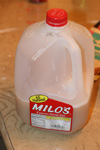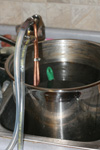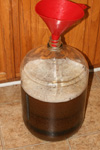Brewing my Big Irish Red Ale - Issues Galore
After far too much time between brewdays, I finally brewed that big Irish red ale (partial mash) that I've been planning for a solid six months. I've obviously been looking forward to this for some time - more than just the time between batches of beer, this also happens to be my very first recipe that I count as "mine", so I have been excited.
Please do note that while I do consider this to be my recipe, I do not pretend that this is something that I created from thin air. I did base my recipe on the well-reviewed Movaje Red by Malticulous. That original recipe was for an American red ale with more of a hop presence that I was looking for, but it gave me a reliable starting point to work from. I "Irished" it up by swapping out the base malt (Maris Otter instead of American two row), subbing out the hops for UK varieties (trading Palisade, Sterling, and Williamette for Challenger, Fuggles, and Northdown), and removing the dry hop (Cascade) step. While the proportions all fall within the ranges for Irish red ales, my recipe slightly exceeds the upper bounds of the style guidelines for gravity, IBUs, and alcohol by volume. Personally, I thnk that this will be a good thing; regardless, you have my logic for reffering to this as a "big" Irish red.
As an aside, this was my first time to actually use my local homebrewing store (Alabrew in Pelham, Alabama). Always before, I had used Autin Homebrew; while they have been excellent to me, I thought that it would be good to give the LHBS a try, since I would be out and close to them. The purchasing experience was excellent; they had all of my ingredients ready for me when I arrived, and the pricing was actually a few dollars cheaper than AHS would have run me. I was happy with the experience, and will likly use Alabrew in the future.
Unfortuntely, I'm pessimistic about how this beer will turn out. Prior to this batch, I hadn't had what I consider to be truly serious issues (provided that you don't count ridiculously late brewing sessions as a bad thing), but this time around, I managed to concentrate several mistakes into one single batch of beer.
 My first mistake came on Saturday night, aka, the night before I brewed. I had decided to make a nice, big starter to help ensure that I'd have a high enough cell count for a good fermentation. Starters are extremely easy to make, and so, I stepped through the process pretty much on autopilot. I thoroughly washed out a plastic sweet tea jug, boiled my water, dissolved my dry malt extract, cooled it, poured it, and pitched my yeast.
My first mistake came on Saturday night, aka, the night before I brewed. I had decided to make a nice, big starter to help ensure that I'd have a high enough cell count for a good fermentation. Starters are extremely easy to make, and so, I stepped through the process pretty much on autopilot. I thoroughly washed out a plastic sweet tea jug, boiled my water, dissolved my dry malt extract, cooled it, poured it, and pitched my yeast.
Only after pitching did I realize that I forgot to sanitize the jug used to hold the starter. Unfortunately, I did not have another vial of yeast (nor enough extract to do another starter), and the LHBS is closed on Sunday. I decided to press on, hoping that I would get enough yeast growth to choke out any nasties that might decide to try to take hold.
For what it's worth, the starter seemed to do really well - I kept the lid sitting loosely on top, but would tighten it every time prior to shaking. This process instantly caused the pastic jug to swell to the point that I worried about an explosion; I would loosen the cap to vent the pressure, then repeat the process every time I thought about the starter sitting there on the table.
 My next major issue came on brewday itself. This time around, my three year old (Jonah) decided to be my brewing buddy, as my five year old (Noah) had more interesting things to do. This was fine, except when it came to mashing.
My next major issue came on brewday itself. This time around, my three year old (Jonah) decided to be my brewing buddy, as my five year old (Noah) had more interesting things to do. This was fine, except when it came to mashing.
Due to equipment limitations, I am still doing a partial mash/beer in a bag method. Basically, I drop that grain bag into my brew pot, pour my mash water in, then wrap the pot with several towels, and finally wrap it with multiple blankets. Last time around, I only lost four degrees of heat over my entire hour's mash, so I felt confident that things would go well for me this time.
Sadly, I didn't take my brew buddy into account. Apparently, Jonah objected to his personal blanket being used in this manner, so he decided to remove it from my pot. In the process, he removed most of my wrappings, and I did not pick up on this fact for a solid fifteen mintes. When I realized what had happened, my mash temp had already dropped to 140 degrees (my target was 152)... and I was still not quite a half hour into the process.
In desperation, I added three quarts of 170 degree water, but the water temp was still a poor 144 at the end of the mash. I know that the extract will help - this won't be quite the disaster level that it would have been in an all grain batch - but I'm figuring that this beer is going to seriously lack body.
 Of course, there was nothing to do at this point but to press on. At least the boil process itself went fine, with no boilovers or other problems. Noah finally decided that he needed to help, so he made my final hop addiiton for me (Jonah did a great job on the first two). I hit my gravity target almost perfectly (1.068 vs the 1.064 I was shooting for); at least that was one good sign. And hey, I got my chiller woes from the last batch resolved; I had the beer down to pitching temperature in fifteen mintes.
Of course, there was nothing to do at this point but to press on. At least the boil process itself went fine, with no boilovers or other problems. Noah finally decided that he needed to help, so he made my final hop addiiton for me (Jonah did a great job on the first two). I hit my gravity target almost perfectly (1.068 vs the 1.064 I was shooting for); at least that was one good sign. And hey, I got my chiller woes from the last batch resolved; I had the beer down to pitching temperature in fifteen mintes.
My final issue relates to temperature control. On the bright side, I did get confirmation that my starter did well - at a mere three hours after pitching the yeast, I had a nice krausen too go along with serious bubbling from my blowoff tube (I have learned that lesson - no more airlocks for me until after active fermentation is over). I didn't think to check again until the following morning when I was literally on my way out the door, and yes, it was throwing gunk out via blowoff tube... but my sticky thermometer reported almost 77 degrees temp, even with the carboy sitting in my cool basement directly on the concrete floor. That sucker was a beast!
 The yeast strain I used was WLP004, with a recommended upper temp range of no more than 68-70 degrees. Homework tells me to expect a serious increase in ester production, which I can live with; I don't mind if this beer isn't perfectly to style, and I really enjoy fruity esters in my beers. On the other hand, I have also read that I may very well be looking at fusel alcohols at this temp; suffice it to say that I will not be happy with those.
The yeast strain I used was WLP004, with a recommended upper temp range of no more than 68-70 degrees. Homework tells me to expect a serious increase in ester production, which I can live with; I don't mind if this beer isn't perfectly to style, and I really enjoy fruity esters in my beers. On the other hand, I have also read that I may very well be looking at fusel alcohols at this temp; suffice it to say that I will not be happy with those.
Monday night after work, I was unable to secure a tub for giving a water bath; in desperation, I resorted to "blue ice" packs, of the sort you find in insulated picnic bags and the like. At that point, fermentation had been going for nearly 24 hours, and the sticky thermometer was down to 74 degrees. By the following morning, my temp was at 67 or so, where it remained pretty steadily for the balance of the active fermentation period of the next couple of days.
How badly will twenty-four hours at that high of a temperature damage this beer? Will it be permenant damage, or will it be the sort of thing that time can heal?
Obviously, there is no way to know at this point. My plan is to leave this beer for a full four weeks in primary, rack it to secondary for two weeks, then bottle. Yes, I do still secondary, and I plan to continue the practice - read back on my experiences bottling the Belgian blonde, if you care to know why.
I figure that, by Christmas, I ought to have a really good idea as to how this beer will turn out. Hopefully, I'll get the gift of some quality beer in spite of my boneheadedness. If not... well, at least I got the opportunity to learn a few lessons, and hopefully, I'll pay attention and not repeat those mistakes in the future.
One thing is certain - I'll have some sort of temperature control in place before I brew again.
Permalink
Tags for this post: irish, red, ale, beer, homebrew, temperature, control, mash, temp, sanitation






Please support BrewUnited by using our Amazon affiliate link when doing any shopping there - be it for homebrewing or for your regular shopping!
2 Comments
Olan needs a personal "beer" blanket for Christmas.
posted by Alacrity on 11/06/2012 at 02:56:47 PM
That's why I brew at night when the kids are gone to bed.
On your starter it's better to let the cap sit loosely so that your starter can breathe, or just use a piece of foil to cover the opening.
Try and find an old small fridge that still works to use as your fermentation chamber - makes temp control a breeze.
Hope it turns out good despite the issues, it probably will. I've had my first bad batch in about 20 brews, I'll give it a few months to see if time heals it.
Cheers,
Aidan
http://beerandgarden.com/
posted by Aidan Curran on 12/13/2012 at 11:00:46 AM

